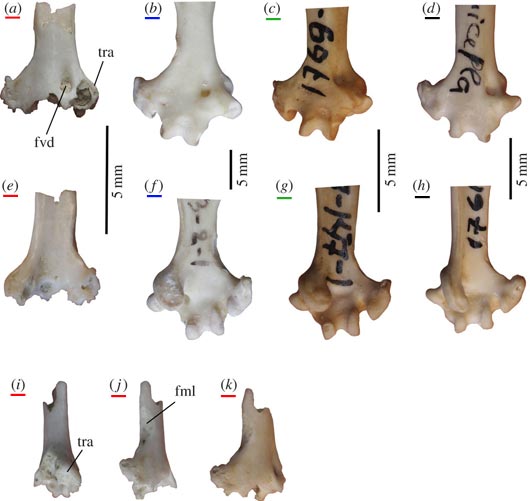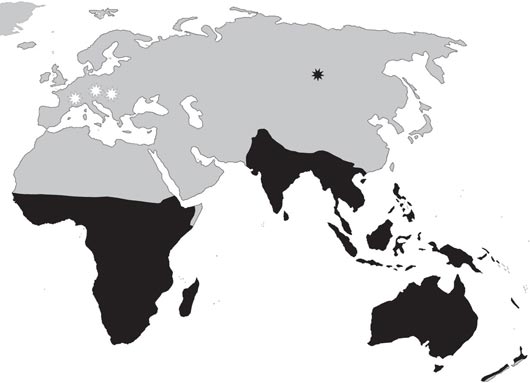The First Fossil Parrot from Siberia
Prehistoric “Polly” Challenges View on Ancient Parrot Radiation and Dispersal
A partial tarsometatarsus bone from Siberia proves that ancient parrots lived much further north in the past. This fragment of fossil parrot bone, dating from around 18-16 million years ago was discovered in the Lake Baikal region of Siberia.
Fossil Parrot Bone
This is the first time parrot fossils have been found in Siberia or the whole of Asia for that matter. Parrots are mostly confined to the tropics and sub-tropics of our world today. The parrots (Order Psittaciformes), are represented by nearly 400 hundred species and they are found throughout Africa, Asia, Australasia and the New World. This fossil discovery, a single bone that measures around half a centimetre in length has challenged the view that parrots spread into the New World by crossing the Atlantic from Africa.
Another route will have to be considered, a movement east across the northern latitudes of Siberia and down into the New World from Alaska.
The Fragment of Fossil Bone Compared to Extant Specimens
Picture credit: Dr Nikita Zelenkov (Borissiak Palaeontological Institute of the Russian Academy of Sciences) with additional annotation by Everything Dinosaur
The picture above shows the tiny fragment of the tarsometatarsus of the Miocene parrot (a, e, i, j, k) compared to other fossil specimens and tarsometatarsus bones from extant species.
Key
_ = specimen number PIN 2614/218 Early Miocene of Tagay (eastern Siberia)
_ = tarsometatarsus of the Yellow-Tailed Black Cockatoo (from Australia) Calyptorhynchus funereus
_ = tarsometatarsus of the Cuban Parakeet (Aratinga euops)
_ = tarsometatarsus of the Black-capped Lory (Lorius lory) of New Guinea
Psittaciformes Dispersal Routes
The fossil was discovered at Tagay Bay, Olkhon island (Lake Baikal) in the Irkutsk Region of Eastern Siberia, Russia. This location (Khalagay Formation), has yielded a number of Early Miocene vertebrate fossils including rodents, members of the rhino family, hippos and cats. The deposits are also famous for the number of bird fossil specimens found. It is the only location in Asia where Early Miocene Aves fossils have been found. Author of the scientific paper, describing this discovery, Dr Nikita Zelenkov of the Borissiak Palaeontological Institute of the Russian Academy of Sciences explained the significance of this fossil:
“This locality is also interesting because it preserves a rich community of fossil birds. But no exotic birds have been found there before. Unfortunately, this find is not good enough to reconstruct the appearance or lifestyle of this parrot, but we can see that it was rather similar to modern ones. So, it was likely a very modern-looking small bird, around the size of a budgerigar.”
For models and replicas of Miocene creatures and other extinct animals: Wild Safari Prehistoric Animal Models.
Links to a Fossil Parrot Bone Found in Germany
It shares features with another earlier fossil parrot bone in Germany, reported in a study published in 2010, belonging to a species called Mogontiacopsitta miocaena. However, no parrot fossils have been found this far north before, or indeed in Asia. This suggests that parrots may have spread to the New World via an eastern route rather than flying across the Atlantic from Africa, a hypothesis favoured by many palaeontologists until the unearthing of this new fossil evidence.
A Map Showing the Old World Distribution of Psittaciformes and Parrot Fossil Finds
Picture credit: Biology Letters
The map above shows current Old World distribution of parrots (black area), Miocene finds of parrots in Europe including Mogontiacopsitta (white stars) and the position of Tagay locality (black star) where the tarsometatarsus fragment was found.
What is a Tarsometatarsus?
To a vertebrate palaeontologist, the tarsometatarsus is a very important bone. It is a relatively long, lower leg bone found only in the skeletons of birds and certain types of dinosaur. It is fully fused in modern birds although, in prehistoric bird types, the fusion is somewhat different and far from complete, for example in the enantiornithines, a diverse group of Mesozoic birds that died out at the end of the Cretaceous, the bones that form the tarsometatarsus were only partially fused along their length. The bones that make up the tarsometatarsus are represented by the ankle and toe bones (metatarsals) in mammals and other types of archosaur.
The scientific paper (Biology Letters): “The First Fossil Parrot (Aves, Psittaciformes) from Siberia and its Implications for the Historical Biogeography of Psittaciformes.”
Visit Everything Dinosaur’s website: Everything Dinosaur.



